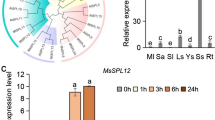Abstract
Cauliflower (Brassica oleracea var. botrytis) tolerates treatment with 25 µM CdCl2 for eight days, but is killed by that with a 50 µM concentration. However, even 15 µM CdCl2 is toxic in the presence of 1 mM L-buthionine sulfoximine (BSO), suggesting the presence of a Cd-inducible phytochelatin and its involvement in Cd-tolerance in cauliflower. To develop heavy metal-tolerant transgenic plants, we ligated the structural gene of yeast metallothionein gene (CUP1) downstream of CaMV35S promoter and introduced the fused gene into cauliflower. A Cd-tolerant transgenic cauliflower was selected, which grew well in the presence of 400 µM or less Cd, whereas the non-transformed cauliflower tolerated only up to 25 µM Cd. The transgenic cauliflower accumulated more Cd, especially in the upper leaves, than the non-transformed plant.
In conclusion, by transfer of the yeast metallothionein gene into cauliflower increased Cd-tolerance and Cd-accumulating ability can be conferred to the plant.
Similar content being viewed by others
References
Butt T R. Sternberg E J, Gorman J A, Clark P, Hamer D, Rosenberg M and Crooke S T 1984 Copper metallothionein of yeast, structure of the gene, and regulation of expression. Proc. Natl. Acad. Sci. USA 81, 3332-3336.
Chen J and Goldsbrough P B 1994 Increased activity of γ-glutamylcysteine synthetase in tomato cells selected for cadmium tolerance. Plant Physiol. 106, 233-239.
Grill E, Foffler S, Winnacker E L and Zenk M 1989 Phytochelatins, the heavy metal-binding peptides of plants, are synthesized from glutathione by specific γ-glutamylcysteine dipeptidyl transpeptidase (phytochelatin synthase). Proc. Natl. Acad. Sci. USA 86, 6838-6842.
Karin M, Najarian R. Haslinger A, Valenzuela P, Welch J and Fogel S 1984 Primary structure and transcription of an amplified genetic locus: The CUP1locus of yeast. Proc. Natl. Acad. Sci. USA 81, 337-341.
Kramer U, Cotter-Howells J D, Charnock J M, Baker A J M and Smith J A C 1996 Free histidine as a metal chelator in plants that accumulate nickel. Nature 379, 635-638.
Lasat M M, Baker A J M and Kochian V 1996 Physiological characterization of root Zn2+absorption and translocation to shoot in Zn hyperaccumulator and nonaccumulator species of Thlaspi. Plant Physiol. 122, 1715-1722.
Misra S, and Gedamu L 1989 Heavy metal tolerant transgenic Brassica napusL. and Nicotiana tabacumL. Plants. Theor. Appl. Genet. 78, 161-168.
Reese R N and Wagner G J 1987 Effects of buthionine sulfoximine on Cd-binding peptide levels in suspension-cultured tobacco cells treated with Cd, Zn, or Cu. Plant Physiol. 84, 574-577.
Author information
Authors and Affiliations
Rights and permissions
About this article
Cite this article
Hasegawa, I., Terada, E., Sunairi, M. et al. Genetic improvement of heavy metal tolerance in plants by transfer of the yeast metallothionein gene (CUP1). Plant and Soil 196, 277–281 (1997). https://doi.org/10.1023/A:1004222612602
Issue Date:
DOI: https://doi.org/10.1023/A:1004222612602




